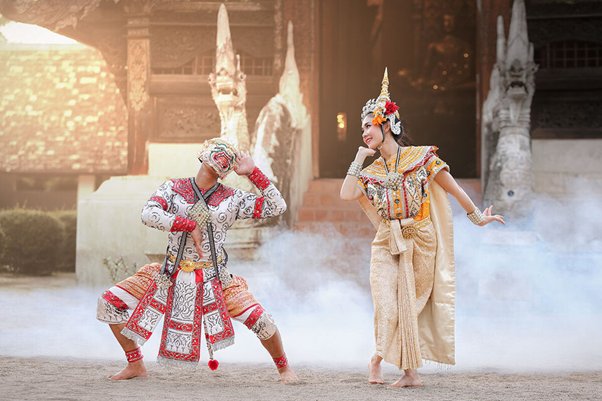In a busy alleyway behind Bangkok’s Grand Palace, the distant sound of piphat music played in classical style drifts through the morning air. In a simple rehearsal room, a lone figure stretches, clothed in elaborate garb, and fastens on a golden mask with tender respect. He is Master Prasert — considered by many to be the last traditionally trained Khon dancer in Bangkok who continues to perform and teach full-time. As Thailand hurtles into the modern age, centuries-old cultural practices such as the Khon dance hang in the balance of survival and are kept alive by a handful of devoted custodians such as himself.
Thailand’s cultural richness is a magnet to visitors who flock to its temples, floating markets, and Muay Thai rings. But fewer know about Khon, the masked dance drama with complex choreography formerly staged only for royal courts. When other visitors choose the mainstream sights, visitors who are curious to discover Thailand’s intangible heritage can usually catch a show at Sala Chalermkrung Royal Theatre. For tourists who wish to experience the depth of Thai craftsmanship from other provinces, reserving bus tickets in Thailand offers inexpensive, hassle-free transportation to cultural centers such as Chiang Mai, Ayutthaya, or even lesser provinces where Khon still lingers in community temples.
What is Khon? A Glimpse Into the Royal Stage
Khon is more than a dance — it’s a visual epic of Thailand’s spiritual and historical heritage. Combining dance, drama, music, and elaborate costuming, Khon dances reenact episodes of the Ramakien, the Thai adaptation of India’s Ramayana. Dancers never speak; they are accompanied by a narrator who recites the narrative while musicians add percussive beats and wind instrument accompaniments. The dancers, dressed in shimmering silk costumes and traditional masks, employ stylized movements to express emotion and tell the story.
Traditionally, Khon was a courtly performance art shown to palace audiences. It wasn’t until the early 20th century that the masses were able to see the splendor of Khon. Even as it gained greater access, the art itself never fully became a part of popular entertainment, and its existence today rests heavily on patronage from the state and personal devotion.
The Decline of a National Treasure
The demise of Khon isn’t because of ugliness or lack of significance — Khon falls victim to the contemporary lifestyle. In a world of TikTok clips and Hollywood films, younger Thai generations consider Khon too sluggish, too outdated, or too complex to learn. Training is rigorous; it requires years of dedication to master finger techniques, physical postures, and footwork.
During the 20th century, King Bhumibol Adulyadej was responsible for the revival of Khon, facilitating its transition from court settings to public stages. Queen Sirikit, The Queen Mother, later supported the art form by sponsoring performances and incorporating Khon into cultural festivals. Their efforts were responsible for bringing attention to Khon, but maintaining its practice is a challenge, particularly with the passing or retirement of prime masters.
Sala Chalermkrung Royal Theatre: A Light of Tradition
One of Bangkok’s few surviving stages consistently presenting Khon is the Sala Chalermkrung Royal Theatre, first built in 1933. Funded by the Ministry of Culture and frequently supported by the Thai royal family, this theatre is at the forefront of maintaining and promoting Khon to contemporary audiences.
The performances here are abridged versions of Ramakien tales, hence more accessible to tourists and locals. The dancers are frequently students from specialized universities or schools, perpetuating a chain of cultural transmission that has been centuries long.
The role of the theater extends beyond entertainment — it is a living museum where people see not only a performance but the continued life of a national treasure.
Her Majesty Queen Sirikit and Royal Conservation Efforts
One of the major driving forces of the contemporary rebirth of Khon is Her Majesty Queen Sirikit, the Queen Mother. During the late 20th century, she undertook large-scale projects to revive Thai traditional arts, one of which was Khon. She supported finances for performances, commissioned costumes, and set up official schools for youth dancers.
In a Thailand Now article, it’s mentioned that Her Majesty and the late King Bhumibol Adulyadej considered Khon a pillar of Thai identity. Their royal patronage revived the art, with performances being held for national and international audiences.
Why Khon Matters
Khon is not going to draw crowds or become a viral sensation on social media, but it represents centuries of Thai values, beliefs, and aesthetics. Every performance is a carefully constructed mixture of literature, spirituality, and visual presentation. To lose Khon would be to lose part of Thailand’s heart.
Other than its art, Khon is also a lesson in patience, respect for heritage, and self-mastery — values that are still very relevant today despite the acceleration of times.
As UNESCO put it, “Khon reinforces a sense of cultural identity among its performers and audiences.” It’s not just dancing; it’s national pride embodied.
Conclusion: Keeping the Past Alive, One Step at a Time
Amidst the chaos of contemporary Bangkok, it is perhaps easy to overlook a performance such as Khon — tranquil, elegant, and disciplined. But for the audience member who finds a seat in Sala Chalermkrung or beholds the elegance of a masked dancer, the experience is one not soon forgotten.






Leave a Reply